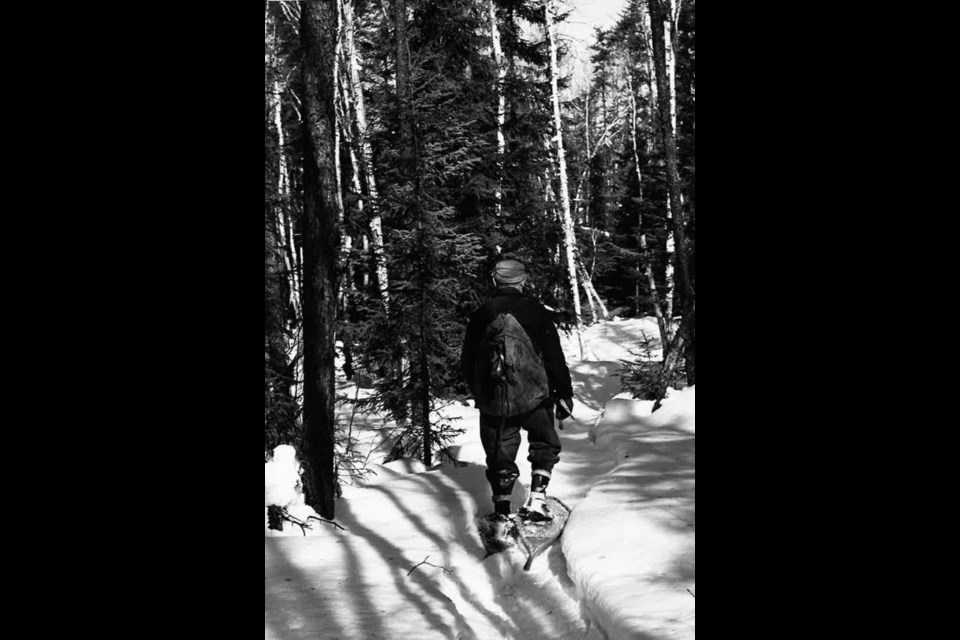It is safe to say that we here in Northern Ontario are blessed when it comes to the natural beauty of the environment that surrounds us, and for the winter outdoor enthusiast it is not any different. There are a number of activities that our region has to offer, including snowmobiling, skiing (both downhill and cross-country), and snowshoeing to name a few.
Les Perrine and the members of the Algoma Snowshoe Club provided a memorable experience to those who were prepared to traverse the scenic, but scraggy region known as Algoma.
Popular in the 1940s and 1950s, there were a series of trails and cabins along the largest inland lake which commenced at the north end of the Sand River. The idea was to be able to trek from Sand River to Lake Superior with lodging along the way for a night’s rest before the next day’s journey.
In total, the dream was to have seven modest cabins along the route. These charming lodgings were to provide the essential elements for survival and were built with what was available.
Each cabin was constructed with moss and wood-shaving insulation and sealed to protect inhabitants from the weather and insects seeking refuge. With the exception of the first cabin, they were constructed on poles about shoulder height, to hopefully deter bear and other critter invasions.
In the summer of 1958, it was discovered that some suspicious activity had occurred at the cabins during portage season.
When examining the scene, it was clear that disruptive behaviour was caused by two bear bandits that wreaked havoc on these humble cabins in search of some sustenance. Which is eerily reminiscent of a cartoon about two mischievous bears from our childhood, is it not?
Teeth marks were analyzed, similar to fingerprints to conclude that a larger bear, affectionately called Old Bald Ear, aided his accomplice into the cabin (Sault Star, Nov. 1, 1958).
These furry bandits, trying to fatten up for the winter months, raided the food stores available at the cabin. These two bandits were clever and had very distinguished tastes.
The younger accomplice devoured many of the more accessible treats in the cabin and proceeded to throw tins out to the older bear. It was noted by hikers that during the initial raids there were only cans of fruit that littered the landscape, with their contents being eaten by the larger bear; in later raids tins of meat and veggies were shared as well.
The cabins were used on an honour system, where each inhabitant was expected to have wood supplies restored, food supplies restocked, and to follow the preventative measures to avoid raids for unwanted visitors, such as the bears mentioned above.
As you can imagine, this duo of bears exhausted the food supplies that were made available during their successive raids.
Being desperate, the bear bandits bit into some less savoury items, such as batteries, lamp fuel cans, construction materials, and the most worrisome, lime chloride. This enraged the older bear, which led to the destruction of cabin number two. It also left damage to the bear himself, it burnt hair off his ear (hence the name Old Bald Ear), and left him blind in one eye.
Despite his condition, Old Bald Ear and his partner in crime moved on to dine on food storages along the trail for a time, only to return to cabin number two to wreak more havoc and consume whatever he was able to get his paws on. This time, however, it was a softener for repairing snowshoes (castor oil), and rat poison. As many know, when castor oil is consumed it leads to the dismissal of waste, so consequently, the poison was unable to end the raids of these unwanted guests.
In desperation, the hikers resorted to primitive methods to combat the bear bandits, by luring the elder bandit in an enclosure that no air was able to penetrate. Unfortunately, for this elder bear, his raiding days ended that day, and outdoor enthusiasts, both hikers and those on snowshoes, were able to make use of the cabins without worry.
In the day of the hustle and bustle, it is refreshing to think of a time when the outdoor lover was able to disconnect, enjoy the wilderness, and what the quiet has to offer. Anyone for some snowshoeing?
Each week, the Sault Ste. Marie Public Library and its Archives provides SooToday readers with a glimpse of the city’s past.
Find out more of what the Public Library has to offer at www.ssmpl.ca and look for more Remember This? columns here.
